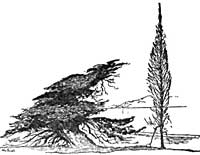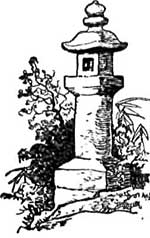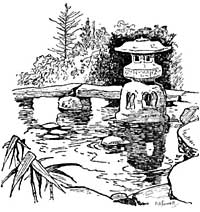A TOUR OF THE GARDENS

Waterfall from Upper Lake to Garden Lake.
To see Newstead Abbey without seeing its gardens would be to miss half the pleasure of the visit; for the gardens are not only charming in themselves, but also afford fresh vistas of the Abbey itself, while for the Byron student they have the special interest of including the famous "Byron's Oak" and the equally famous tomb and monument of his favourite dog, "Boatswain." As for the gardens themselves, the fact that they cover no less than twenty acres and are traversed by paths which total more than five miles in length gives some idea of their expanse. It is, however, not necessary to embark upon a five-mile walk in order to inspect them, for the use of a selection of the paths, indicated by the dotted route on the detailed plan (pages 16 and 17) will enable their varied attractions to be seen with a minimum of effort. Visitors are strongly recommended to follow the route shown on the plan, both to ensure that they do not miss any features of interest and also as a precaution against unconsciously retracing their steps instead of making headway towards fresh delights. In addition to the gardens in the more strict sense of the word, the spacious grounds of Newstead are adorned with many notable trees—notable in some cases for rarity of species and in others for their interesting associations.

Vase in the grounds.
The entrance gate to the gardens will be found at the south-west corner of the modern wing, which projects from the main west front of the mansion. At the gate itself we may pause for a moment to look across the upper end of the Garden Lake, where the water tumbles over a little cataract a short distance below the nobler waterfall by which it descends from the Upper Lake. As we commence to follow the pathway leading from the gate beside the Garden Lake towards the Abbey gardens, one of the first objects to catch the eye is an interesting old cedar tree which was evidently blown down many years ago, but which succeeded in keeping a grip on Mother Earth by its roots and thus went on growing in an almost recumbent position—leaning on its elbows, as it were. At the back of this fallen cedar rises the fine spire of an American (Mexican) cypress, a tree rarely seen in this country.
Continuing along the lake-side path, there are seen across the water two or three trees of special interest. One of them (marked "A" on plan) was planted by Dr. Livingstone, the famous missionary-explorer of Central Africa, who often stayed at Newstead, while the other (marked " B " on the plan) was planted by Mr. Stanley when on a visit to Newstead.
It is perhaps as well to say here that in the course of our progress along this path we shall find ourselves passing certain interesting features on the left—notably Byron's Oak and the Prior's Kitchen—but these will be referred to in due course when our route brings us nearer to them.

The fallen cedar.
Just before reaching the lower end of the Garden Lake, we may notice on detail close to the path on the left-hand side—the handsome stone vase of classic Greek design which is shown in one of our smaller illustrations (see above). At the lower end of the Garden Lake, a long colonnaded summer-house is seen curving round close to the water, and at the nearer end of this the lake falls over a weir so as to give the benefit of its flowing water to the beautiful Japanese Garden which lies immediately below. The visitor should take a general view of this charming garden from the vantage-ground of the bridge over the weir before descending the steps to inspect it at close quarters.
The Japanese Garden at Newstead is as fine a specimen of this distinctively national style of gardening as one may hope to see in Britain. There are a few others elsewhere, but none more beautiful and probably none so thoroughly carried out as this one. It was constructed by Miss Webb, daughter of a former owner of Newstead Abbey, early in the present century, so that it is now mature and well-established. The great charm of the Japanese method of decorative gardening consists in the absence of formality or flatness or straight lines. Rather does it seem to be a work of Nature herself, and this spirit is well expressed in the example we have here. Nearly all the trees and ornaments as well as many of the plants in the Japanese garden actually came from Japan, so that we are fully entitled to regard what we see here as "the real thing." The thing which made the construction of such a garden possible was, of course, the presence of the stream which flows through the Newstead lakes— for water plays a large part in Japanese garden planning. The water flows with crystal clearness between the rock groups and is crossed by little stone bridges which, often in company with neighbouring garden ornaments, are seen reflected in it, presenting us with a series of very delightful pictures.

Stone lantern in Japanses Garden.
The ornaments include stone "lanterns" of the characteristic Japanese design, with a suggestion of the pagoda or of a temple roof about their lines. In the centre of the garden is a Japanese Tea-house. Water lilies and other water plants flourish in the quieter pools.
Having made a circuit of the Japanese garden, which well deserves detailed examination, we pass on, as indicated on the plan, into the Rock Garden, the approach to which is marked by a great wealth of hart's-tongue ferns lining the banks of one of the diverted streams. From this point to the point "D" on plan, visitors should make an inspection of the Azalea Garden, the Rock Garden, and other Gardens, rejoining the line of direction at the point marked "D." The Rock Garden with its splendid collection of Alpines and other appropriate plants, was also a work of Miss Webb during the early years of the century. The stones used in its construction include many which are evidently odd fragments from the Abbey ruins, for the mark of the mason can be seen in the moulding and shaping of many of them.

In the Japanese Garden.
From the Rock Garden we emerge on to a lovely old lawn across which is seen a pretty stone cottage, the home of one of the gardeners. This lawn is surrounded by many kinds of flowering shrubs, among which azaleas strike the dominant note. It is well to pause for a moment here to notice the two grand old cedar trees adjacent, as well as the trimmed yew hedge—also of great age—which extends almost like a wall of green rock from a corner of the gardener's cottage. Another notable detail here is a flowering tulip tree (marked "C" on plan).
